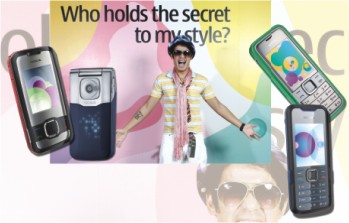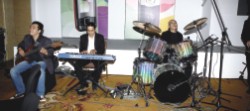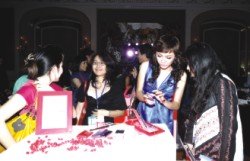| Event
Connected in Style
Colours, shades and textures set people apart in style, with Nokia's new Supernova range of mobile phones, recently launched in Vietnam. Kajalie Shehreen Islam, back from Ho Chi Minh City
If there's anything that people around the world have in common, it's style. Whether they're dressed to kill or prefer to keep it simple or be casually careless, everyone has their own style. Clothes, shoes, accessories, everything on us says something about who we are. So why not our cell phones? For all the vibrant people who love to dress in bright colours, a black or even silver phone hardly meets their needs. Or for those who don't like it plain, solid phone covers are boring! And let's not even start on the bulky mobile phones of what seem like the yesteryears. Yet, there are colours and textures and styles that everyone likes, only, suited to their own personalities.

At the Nokia Design Studio in London, 300 designers from over 30 countries work to discover the "common threads of humanity", according to Senior Design Manager, David Gratiot, while at the same time inventing ways to set people apart from each other in terms of style.
The Nokia Supernova series, launched last weekend at the Park Hyatt Hotel in Ho Chi Minh City, Vietnam, is all about style and making your cell phone meet your look. Following a presentation on the phones, models walked the ramp to different music to suit the different styles of the phones, from young and hip rock to soft, soothing pop. Just before dinner, guests, assisted by the models, were able to touch and feel the various devices in small booths set up for the occasion.
 Along with exceptional mobile functionality and a variety of music and internet experiences, the Nokia Supernova range is aimed at style-conscious women and men who want to stand out in a variety of hues and textures from shades of pink, purple, red, brown, yellow, blue and green to three-dimensional textured designs. The inspiration for the line, says Gratiot, comes from everything, everywhere, but particular from the latest statement handbags and must-have sunglasses. The colours and textures of handbags, the bands and reflective lenses of sunglasses all acted as inspiration for this series, from the covers to the screens and sides of the phones, of which the first four devices have been launched. "With the advancement in technology today," says Gratiot, "style is universal." Along with exceptional mobile functionality and a variety of music and internet experiences, the Nokia Supernova range is aimed at style-conscious women and men who want to stand out in a variety of hues and textures from shades of pink, purple, red, brown, yellow, blue and green to three-dimensional textured designs. The inspiration for the line, says Gratiot, comes from everything, everywhere, but particular from the latest statement handbags and must-have sunglasses. The colours and textures of handbags, the bands and reflective lenses of sunglasses all acted as inspiration for this series, from the covers to the screens and sides of the phones, of which the first four devices have been launched. "With the advancement in technology today," says Gratiot, "style is universal."
"The Supernova series, standing for optimism and bravery, helps to personalise phones, making this series distinctly different from other Nokia products."
The Nokia 7210, 7310, 7510 and 7610 Supernova each make a statement of their own and of their users. The first, for trend watchers who wish to combine style and simplicity, is a chic, slim phone which will be available later this year in "bubble gum pink" and "vivid blue". A 2 megapixel camera and access to Flickr allows one-click access and photo-sharing.
 |
Models demonstrate special features of the newly-launched Supernova series. |
This is made even easier in the 7310 with TV out which allows the user to connect to and show photos on their television screen. Also slim and sleek, this device has exchangeable Xpress-On covers with three-dimensional textured designs. This model will first be available in "steel blue" plus a second front and back cover in "wasabi green" or "candy pink" with a 2 megapixel camera,
MP3 music player and more. More colours in "mushroom silver", "plum jam", "electric blue", "yellow mellow", "espresso brown" and "wasabi green" will also be available later.
For flip-phone lovers, the 7510 also has Xpress-On front and back covers in "storm blue", "red", "emerald green" and espresso brown" with magical light effects and a new user-friendly Nokia web browser for easy access to Nokia Search, Share on OVI and Flickr. It also has an FM radio, MP3 player, a link to YouTube, access to Nokia Maps 2.0 to navigate free mapping, routing and local search, all within a large 2.2 inch QVGA display.
Finally, the Nokia 7610 Supernova with slide design has an innovative Theme Colorizer feature which lets people identify and capture any colour and further tailor a look by applying captured colours to the phone's key illumination and wallpaper. Xpress-On covers in "steel blue" and "red" will be available, along with a 3.2 megapixel camera with dual LED flash and 8x zoom, instant messaging and TV out for image-sharing, and, for music buffs, MP3 player with access to Nokia Music Store through the Nokia Music PC Client.
For those who question the relevance of such products in countries labelled by Nokia itself as "Emerging Asia", consisting of Bangladesh, Bhutan, Maldives, Nepal and Sri Lanka, the makers are very positive about the expected response.
"Style does not have any borders," says Dolly Chin, Head of Go-To-Market (GTM) Live Category for Nokia Asia Pacific. But, while style is the main emphasis in this range, there has been no compromise with functionality or quality. In fact, says Chin, "This series is great for this group of consumers as it has a number of features not previously available in this price range (USD 150-300, excluding discounts, subsidies, etc.)."
"Instead of buying multiple devices, like an alarm clock, music player, camera, etc." says Ai Fong Wong, Communications Director, Southeast Asia Pacific (SEAP), "you buy just one and have them all in one."
According to Chris Carr, Vice President (VP), Sales, Nokia Southeast Asia Pacifc, Nokia's products are useful in low-income countries, exposing people to a range of devices and experiences to which they previously did not have access. "Many people's first experiences taking photographs on a camera or listening to music on an MP3 player or even with an alarm clock were with Nokia's cell phone camera, MP3 player and clock," says Carr. He also mentions the access to different languages on Nokia phones, the most recent being Khmer, the language of Cambodia, saying such features make the user environment "familiar, comfortable and energising".
"We have 120,000 people conducting research in 27 countries to find out user needs," says Carr, "and we make sure that our products are locally relevant, taking into account social, religious, legal, etc., factors." For example, says Carr, one researcher went and stayed with a family in India who shared one cell phone between the whole family of four. When asked what would make things easier for them, they said they could use separate contact lists for the different users so that each person would not have to scroll through all the contacts of the other family members. Observation and research of all kinds helps producers to be more in sync with their consumers and fulfil their needs and wants. The torch light in some Nokia phones, for example, is a direct response to the needs of people living in rural areas with no electricity.
Mobile phones impact productivity and encourage creativity, believes Carr. He cites the example of a rickshaw-puller in one of Nokia's market countries who, through regular contact over his mobile phone, built a relationship based on trust and confidence with one of his clients who he used to drive to and from work, then pick up groceries she had forgotten at the store to finally driving her children to and from school. "This obviously increased the productivity and income of the rickshaw-puller," says the VP. According to Carr, research has shown that in some countries, for every four mobile phones bought in a hundred, the GDP has increased by 0.6 percent.
"Mobile phones are changing people's lives," says Carr, "as mobility is a stronger story today than ever."
Copyright (R) thedailystar.net 2008 |
